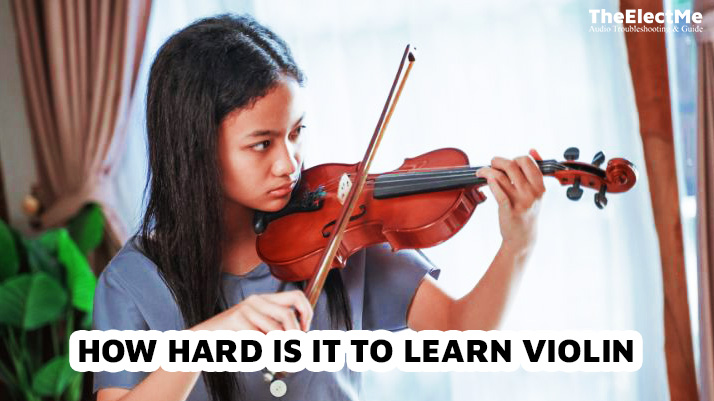How hard is it to learn violin for beginners? Yes, learning a violin is considered a challenging task. But is it impossible? Not. Anyone can learn to play the violin with the right mindset, resources, and determination.
Learning a new instrument requires time, effort, and patience.
And the violin is no exception. It takes dedication and discipline to master this beautiful instrument. However, age, previous musical experience, and learning methods can influence the difficulty level.
So, you have deep knowledge about how hard is it to learn violin for beginners. Let’s explore the factors that can affect the difficulty level of learning violin.

How Hard Is It To Learn Violin? 5 Challenges In Learning The Violin
The violin is a complex and challenging instrument to learn. Playing it requires physical skill, mental focus, and musicality. Therefore, the difficulty level of understanding the violin can vary from person to person.
Here are five factors that can make learning violin difficult for beginners:
Challenge No. 1: Physical Demands and Coordination
Learning the violin involves three essential components. It includes precise finger placement, bow control, and coordination between the left and right hand.
Precise Finger Placement
Proper finger placement is crucial for producing accurate notes on the violin. Beginners must train their fingers to find the correct positions on the strings.
To play the right notes consistently, you need strong fingers and muscle memory. Navigating the fingerboard and finding the correct parts can be challenging at first.
Bow Control
The bow is responsible for producing sound on the violin, and controlling it effectively is vital. Beginners must control the bow’s pressure, speed, and direction to achieve the desired tone and dynamics. Finding the right balance and maintaining consistent bow control takes time and practice.
Coordination between the Left and Right Hand
Playing the violin requires coordination between the left hand (finger placements) and the right hand (bow control). Beginners must synchronize the movements of both hands to produce clean and accurate notes. This coordination can be challenging initially, as it requires precision and timing.

Challenge No. 2: Complexity of Music Theory
Learning the violin involves mastering the physical aspects of playing the instrument and understanding music theory. This covers music notation, scales, key signatures, intonation, and phrasing, which can complicate learning.
Music Notation
To read and interpret sheet music, violinists must understand music notation. This involves identifying symbols for notes, rests, dynamics, articulations, and other musical markings. Beginners need to learn and use symbols for fingerings, bowings, and expressions on the violin.
Scales and Key Signatures
Scales are fundamental building blocks of music, and violinists must be familiar with various scales. Understanding different scales helps violinists navigate melodies more effectively and play in other keys.
Additionally, key signatures indicate the specific set of sharps or flats used in a piece. Mastery of scales and key signatures allows violinists to play in different tonalities and transpositions.
Intonation
Intonation refers to playing in tune, ensuring that each note is accurately pitched. The violin needs precise finger placement, bow pressure, and ear training to maintain intonation. Beginners often struggle with intonation, needing pitch awareness and muscle memory to hit the right notes.
Phrasing
Phrasing involves shaping musical phrases and expressing the intended emotions in a piece. It involves understanding dynamics, articulations, and musical phrasing markings to achieve the desired musicality. Creating expressive phrasing requires technical skill and a deep understanding of the musical context.

Challenge No 3: Patience and Persistence
Mastery of the violin requires consistent and dedicated practice. This can challenge beginners who may feel discouraged or frustrated with slow progress. Learning the violin takes time, and it’s essential to have patience and persistence throughout the journey.
Making mistakes and struggling when learning new skills, including playing the violin, is expected. But with determination and perseverance, anyone can overcome these challenges and continue to improve.

Related: How Long Does It Take To Learn Violin?
Challenge No. 4: Ear Training
Ear training is a crucial aspect of playing the violin as it helps develop a strong sense of pitch and allows for better intonation.
It takes time and practice to train your ear to recognize when you are out of tune and make the necessary adjustments. But with persistence, ear training becomes more accessible, and playing music will become second nature.

Challenge No. 5: Performance Anxiety
Another factor that can make learning the violin challenging is performance anxiety. Many beginners may feel nervous or anxious when playing in front of others. This can affect their performance and make it difficult to showcase their skills.
Performance anxiety is a common struggle for musicians. It’s crucial to address this challenge and find ways to manage it.

Let’s move to the tricks on how to overcome these challenges.
How Do You Overcome The Challenges That Make Violin Learning Difficult?
To overcome the mentioned challenges, here are tips for a more enjoyable and successful violin learning journey:
- Set Realistic Goals: The first step to overcoming any challenge is to set realistic goals for yourself. Start with simpler ones instead of aiming to play a complicated piece perfectly. It will boost your confidence and help you improve your skills comfortably.
- Find a Good Teacher: A good teacher can make all the difference in your violin learning experience. They can help you with techniques and give personal feedback to help you improve. A good teacher will understand your struggles and provide support and encouragement when needed.
- Practice Consistently: As mentioned earlier, mastering the violin requires consistent practice. Create a practice schedule and stick to it, even for a short time each day. It will help build muscle memory and improve your skills over time.
Conclusion – How Hard Is It To Learn Violin?
To summarize, how hard is it to learn violin? The answer is yes; the violin is a complex instrument to learn. It takes time, dedication, and a lot of practice to master. However, anyone can learn how to play the violin with the right mindset, resources, and support from a good teacher.
So, don’t be discouraged if you encounter challenges along the way. Keep practicing, and never give up on your musical journey. Remember that every mistake is an opportunity to improve, and every small victory is a step towards mastering this beautiful instrument.



